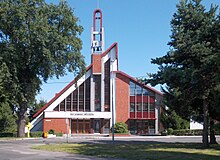Porajów
| Porajów | ||
|---|---|---|

|
|
|
| Basic data | ||
| State : | Poland | |
| Voivodeship : | Lower Silesia | |
| Powiat : | Zgorzelec | |
| Gmina : | Bogatynia | |
| Geographic location : | 50 ° 53 ' N , 14 ° 50' E | |
| Residents : | 1500 | |
| Telephone code : | (+48) 75 | |
| License plate : | DZG | |
| Economy and Transport | ||
| Next international airport : | Dresden | |
| Wroclaw | ||
Porajów (German Großporitsch ) is a village with around 1500 inhabitants in the municipality of Bogatynia in the powiat Zgorzelecki of the Lower Silesian Voivodeship in Poland .
Geographical location
The place is located on the east bank of the Lausitzer Neisse opposite the Saxon city of Zittau and the confluence of the Mandau . By the place of the runs without a stop Neisse Viaduct next railway line Zittau-Liberec . To the south-west is the Zittau-Friedenstraße border crossing, which runs between Zittau and Hrádek nad Nisou one kilometer across Polish territory.
history
Poritsch was first mentioned in 1359. In 1387 the town of Zittau bought the villages of Luptin , Kleinschönau and Poritsch from the burgraves of Dohna on Grafenstein . The village of Poritsch and its manor are probably much older. The place name indicates a Slavic origin of po reka ( on the river ) and was retained during the German settlement after the 12th century.
Until the Upper Lusatian Pönfall in 1547, Poritsch was a place. The distinction arose from the division of the manor between two owners. In 1559, the estate came into the possession of important Zittau patrician families, including the mayor Nicolaus von Dornspach, his brother-in-law Benjamin Schnitter and his son-in-law, the mayor Johann Nesen. When Nesen died in 1654, the Eichler von Auritz owners of the manor were followed by the Schmeiß von Ehrenpreisberg and Christian Traugott von Burgsdorff . In 1769, Gottlob Krusche from Oberseifersdorf bought Großporitsch, and with his son-in-law Johann Friedrich Mönch, the monks became heir, feudal and court lords of the village.
Großporitsch had been parish in Zittau since the introduction of the Reformation. In 1754 a school was inaugurated. In 1838 the old court cretscham was torn down and the "Gasthaus zum Lämmchen" was built in its place, which was later expanded to include a large dance hall and became an establishment popular with the Zittauers. In 1856, after the abolition of the manors in Saxony , Großporitsch became an independent municipality in the Zittau administration . The manor remained in the possession of the Mönch family.
With the construction of the railway line from Zittau to Reichenberg in 1856, which crosses the upper village, Großporitsch received a stop in 1859. A stone viaduct 748 meters long was built over the marshy Neisse meadows north of the village.
On April 1, 1891, the new parade ground of the Zittau barracks was inaugurated in Großporitsch. The airfield of the city of Zittau was built on the Neisse, where the annual Zittauer Flugtage took place. In 1913, the Zeppelin LZ 17 “Sachsen” landed on the airfield during the flight days on its journey from Leipzig to Zittau and back. Until it was discontinued on November 15, 1919, Sächsische Luftreederei GmbH operated the Dresden-Bautzen-Zittau airline from the Dresden-Kaditz airfield . During the Second World War, the airfield was used exclusively for military purposes.
During the First World War, the Großporitsch prisoner-of-war camp was set up north of the village , the barracks of which were dismantled after 1920. On October 1, 1920, Großporitsch was incorporated into Zittau and the place was enlarged by a large number of settlement houses in the following years.
In 1937 Zittau became a barracks location again and construction of a new barracks began on the site of the prisoner-of-war camp, which remained unfinished because the war began. In 1944, the Junker subsidiary Zittwerke AG took over the site and set up a production site for aircraft engines. The barracks area served as a residential camp, and a satellite camp of the Groß-Rosen concentration camp was also housed there. After the occupation by the Red Army , the Zittau war and civil prisoner camp was established in May 1945 .
On June 22, 1945, the Polish army took over the place and expelled the German residents. The Neisse bridge to Zittau was closed, the place was named Porajów and formed a municipality in Poland.
In 1984 a modern style Catholic church was consecrated in Porajów and in 1988 the place got its own cemetery. Porajów now has a grammar school with an attached elementary school.
literature
- Tilo Böhmer / Marita Wolff: In the Zittauer Zipfel. Historical foray through Reichenau and its surroundings. Lusatia-Verlag, Bautzen, 2001, ISBN 3-929091-85-2
- Herbert Bauer: All about the history of a siding , association of the Zittauer Schmalspurbahnen eV, issue 1/2003
Web links
- Großporitzsch in the Digital Historical Directory of Saxony
- http://www.bibliotekazspig.neostrada.pl/porajow/porajow_glowna.htm
- Information for the location ( memento from April 16, 2013 in the web archive archive.today ) (Polish)

